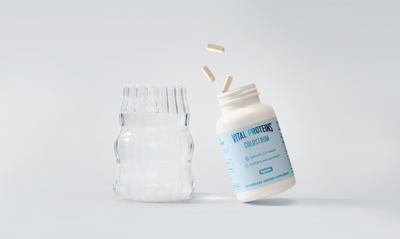At Vital Proteins®, we take our wellness seriously. So, as we work our way through 2020, we thought we’d spotlight some of the most talked-about trends in the industry (outside of collagen, that is!). Come along with us on this health-focused journey. Up first: intermittent fasting!
Oh, intermittent fasting. If you haven’t heard a friend, family member or coworker talk about it by now, you may have a general premise of what it is from Google (it’s trending!). At high-level, intermittent fasting involves partaking in select periods of eating (hence, the ‘fasting’) in an effort to promote better health. While the idea of avoiding an 11 p.m. pint of Ben & Jerrys isn’t exactly news, there’s more to this selective eating than you’d think. We explore this below.

The Basics: What Is Intermittent Fasting?
Let’s start at the very beginning (it’s a very good place to start...). Okay,Sound of Music references aside, this health trend is all about when to eat. For example, Dr. Matthew Taylor, RD, Ph.D references intermittent fasting as a period of time in which caloric consumption is restricted to a small intake or no intake at all.
Of course, to partake in this, one’s in it for the benefits. And, according to a study from the New England Journal of Medicine, there are plenty, including improved metabolism, lowered blood sugar, lessened inflammation and better brain function. For the full list, get educated here.
How To Do An Intermittent Fast
There are several approaches to intermittent fasting. In a study done at the University of Alabama, one of these included monitoring participants in a fast over 12 hours (between 7 a.m. and 7 p.m.), while another involved avoiding food for 24 hours altogether, for 1-2 days a week. That said, Dr. Taylor describes the route of fasting for 16 hours, eating within an 8-hour window (for example, eating from 7 a.m. to 3 p.m.) as the most popular way to do it.
During these periods of restriction, the rule is pretty straightforward — no food is allowed. (Note: Drinks like water, tea and coffee are permitted, along with supplements, as long as they are calorie-free.) Additionally, regimes like keto or paleo are permitted and can be followed during the hours onedoes eat.

How Does Intermittent Fasting Impact Working Out?
The consensus here is to hold off on high-intensity workouts as studies suggest that alternate-day and partial-day fasting require an adaptation phase of several weeks, says Dr. Taylor. After this, people may return to their usual fitness routine. But, as with starting any diet and exercise regimen, it’s important to check in with your body’s response to these changes.
How To Know If Intermittent Fasting Is Right For You
Sure, the idea of hitting “reset,” especially after a long, carb-heavy weekend, sounds appealing. However, there are some things to be mindful of before jumping in. For instance, individuals on medications, who have certain medical histories or are pregnant may not be good candidates for it.
Whether you or not you are one of these individuals, or you just simply are intrigued and have questions, we’d recommend talking to your trusted healthcare provider. They can best provide you with the diagnosis and treatment of any medical condition and assist you as well in deciding whether a dietary change will be conducive to your lifestyle.














